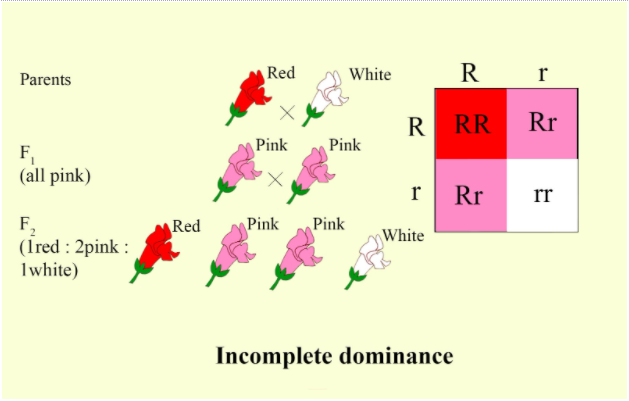
Phenotypic and genotypic ratio in ${ F }_{ 2 }$ generation in incomplete dominance is
(a)1:2:1 and 1:2:1
(b)9:6 and 1:2:1
(c)9:6 and 3:1
(d)9:3:3:1and 1:2:1:4:1:1:2:1:2:1
Answer
563.4k+ views
Hint: Incomplete dominance occurs when a dominant allele does not completely mask the effects of the recessive allele, and the resulting phenotype shows a blending of both alleles. One example is shown in the flowers of snapdragon.
Complete answer:
-It is also called semi-dominance or partial dominance.
-The allele for red color is dominant over the allele for white color, but in heterozygous snapdragons, with both alleles, is pink in color.
-In complete dominance, if an individual is heterozygous for a particular gene, the dominant allele will completely mask the recessive allele.
-Flower-like roses, tulips, carnations also show incomplete dominance.
-Incomplete dominance occurs because neither of the two alleles is fully dominant over the other, or because the dominant allele does not fully mask the product of the recessive allele.
-This gives rise to a phenotype that is different from both the dominant and recessive alleles and is a mixture of both.
-The homozygous red flower has two dominant red alleles, represented by RR. The homozygous white flower is represented by rr. Their offspring ($F_1$ generation) are all heterozygous Rr, and they have pink flowers.
-When the $F_1$ generation is cross-pollinated, their offspring ($F_2$ generation) will be RR, Rr, and rr in a 1:2:1 ratio genotypically.
-The RR flowers will have red color, Rr flowers will have a pink color, and rr flowers will have a white color.
So, the correct answer is ‘1:2:1 and 1:2:1’

Note: -Incomplete dominance is different from codominance.
-In codominance, both alleles are expressed at the same time. Example: ‘A’ gene and ‘B’ are expressed together in human blood cells. These both are dominant alleles.
Complete answer:
-It is also called semi-dominance or partial dominance.
-The allele for red color is dominant over the allele for white color, but in heterozygous snapdragons, with both alleles, is pink in color.
-In complete dominance, if an individual is heterozygous for a particular gene, the dominant allele will completely mask the recessive allele.
-Flower-like roses, tulips, carnations also show incomplete dominance.
-Incomplete dominance occurs because neither of the two alleles is fully dominant over the other, or because the dominant allele does not fully mask the product of the recessive allele.
-This gives rise to a phenotype that is different from both the dominant and recessive alleles and is a mixture of both.
-The homozygous red flower has two dominant red alleles, represented by RR. The homozygous white flower is represented by rr. Their offspring ($F_1$ generation) are all heterozygous Rr, and they have pink flowers.
-When the $F_1$ generation is cross-pollinated, their offspring ($F_2$ generation) will be RR, Rr, and rr in a 1:2:1 ratio genotypically.
-The RR flowers will have red color, Rr flowers will have a pink color, and rr flowers will have a white color.
So, the correct answer is ‘1:2:1 and 1:2:1’

Note: -Incomplete dominance is different from codominance.
-In codominance, both alleles are expressed at the same time. Example: ‘A’ gene and ‘B’ are expressed together in human blood cells. These both are dominant alleles.
Recently Updated Pages
Master Class 12 Business Studies: Engaging Questions & Answers for Success

Master Class 12 Economics: Engaging Questions & Answers for Success

Master Class 12 English: Engaging Questions & Answers for Success

Master Class 12 Maths: Engaging Questions & Answers for Success

Master Class 12 Social Science: Engaging Questions & Answers for Success

Master Class 12 Chemistry: Engaging Questions & Answers for Success

Trending doubts
What are the major means of transport Explain each class 12 social science CBSE

Which are the Top 10 Largest Countries of the World?

Draw a labelled sketch of the human eye class 12 physics CBSE

Explain sex determination in humans with line diag class 12 biology CBSE

The pH of the pancreatic juice is A 64 B 86 C 120 D class 12 biology CBSE

Explain sex determination in humans with the help of class 12 biology CBSE




